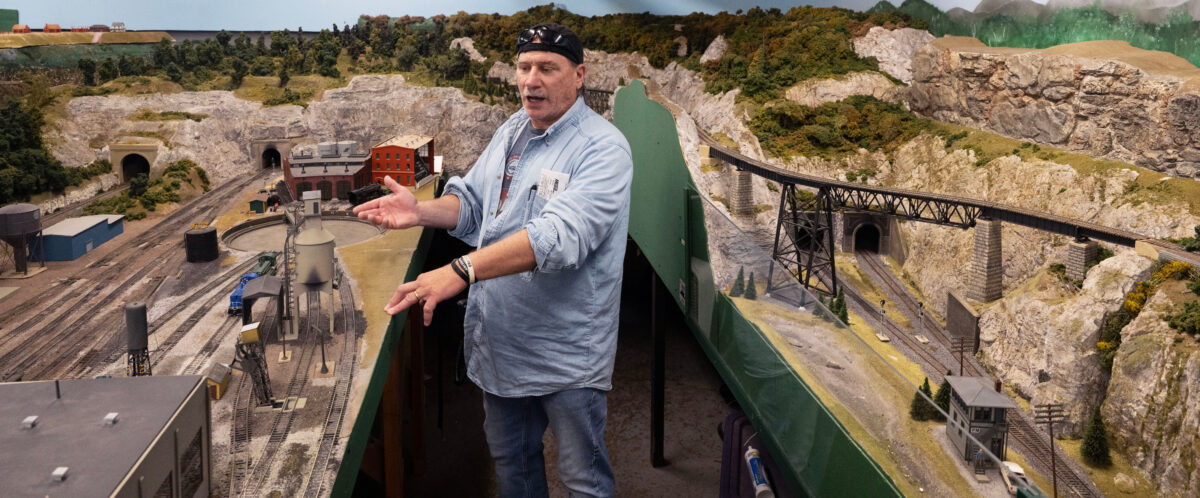Since 1946, model railroad enthusiasts have gathered in the basement of the Calumet Park Fieldhouse to work together on the construction of what amounts to a small civilization. The Lake Shore Model Railroad Association’s (LSMRA) huge network of interlinked, miniature tracks stretch back and forth across the seventy foot basement, a glorious and ever-changing homage to different eras of American infrastructure, methods of manufacturing, and architecture.
The LSMRA’s miniature engines trundle past the city of Calumet—with its fictional radio station, daily newspaper, and re-creation of Skyway Dog House, the popular hot-dog stand less than a mile away from the fieldhouse—and then on to Herod, a recreated pioneer settlement with hard-up miniatures gathered around a campfire. Other, smaller towns lay at the foot of vast bridges and at the end of roads. Along the interlinked lines one finds a coal-washing plant, a cement plant, a power plant, a cold storage plant, and a motorcycle bar. Stands of seafoam trees cluster at the base of cliffs made from rubber molds, trees which one imagines chopped up and bundled in the lumber yard.
The astonishing level of detail speaks to the nearly eighty years of construction, expansion, and revisions carried out by LMSRA members. Founded by thirteen World War II GI’s from Chicago’s South Side, the model railroad has been in continuous operation.
Joe Flens, the club’s longest continuously serving member, has worked on trains large and small for most of his life. Flens followed in the footsteps of his father, a conductor on the Illinois Central Line, becoming a track-layer and later conductor for Metra, where he has worked since 1987. He recalled the sounds and smells of diesel trains wafting up through the windows of his high school, Mt. Carmel on 63rd.
“Our section of Mt. Carmel faced the train tracks, and our windows would be open to get the air in. So the trains would be right there, and all the diesel fuel would become smoke, and come in. I fell in love with the diesels. You could hear the engines rev up, the old engines. You could just feel the shake,” he said.
Flens explained that different members of the LMSRA preferred different models of trains and different eras. Older members generally favored older trains, such as steam engines, Flens said, while young members tended to prefer containerized freight trains, complete with miniature recreations of graffiti sprayed on their sides. Flens likened the appearance of container freight to a solid moving wall, and added that he much preferred that the “piggyback” freight arrangement, where truck trailers with their wheels still on are parked on top of flatcars.


LMSRA treasurer Greg Kelley explained that group members generally opted for realism in their work on the train layout. A previous member had installed a space ship and a Godzilla replica, both of which were later removed. Some LSMRA members also prefer to lay the tracks by hand, gluing each tie to the layout and nailing the rails to the ties. Others buy the tracks pre-made, bending them to fit with each other. The buildings also tend to be bought in prefabricated sets, which members later customize and combine in a process known as “kit bashing.”
Since 1990, Kelley has been one of the chief modernizers of the layout, installing a jungle of wires beneath the train tables to service a centralized dispatch system near the entrance of the room. The dispatchers’ map represents various junctions on the lines, which light up as trains transfer from one point to another. The system enables a single person to control the entire layout, including removing troublesome trains, if necessary.
As in the real world, Kelley explained, modernization initiatives and capital expenditures can attract controversy. When he suggested that the group abandon its former analog system and switch over to Direct Command Control (DCC), he had to allow for members to operate on analog half the time, and on DCC for the rest.
“I’m not bragging, but I wrote a letter before we had DCC saying what it could do, and to make trains more realistic,” Kelley said. “They still wanted to maintain analog. But they wanted a 50-50 arrangement. It ran 50 percent digital, 50 percent analog at first. Then it became 75 digital digital, and 25 analog. And a few years later, the analog was ripped out.”
The layout has tended to reflect and even be affected by broader historical trends. Advances in the semiconductor industry greatly enhanced model train efficiency, Kelley explained. In another reflection of the larger world, the LSMRA has seen a model steel mill come and go (twice) and recently been hit hard by tariffs, which have caused the price of model train components from China to skyrocket.
In the future, Kelley wants to continue modernizing the signal system, while Flens wants to construct a vision of a more prosperous past. Where the intermodal yard now stands, he envisions a gleaming city, complete with skyscrapers from the 1930s, 40s, and 50s.
“I’ve been running on [the model railroad] since I was a kid. It’s in my head. I’d rather have this old town go and build a new city here with a major passenger station,” Flens said.
Lake Shore Model Railroad Association, basement of the Calumet Park District Fieldhouse at 9801 S. Ave. G. Wednesdays and Fridays, 5pm-8pm, (except holidays). lakeshoremodelrr.org

